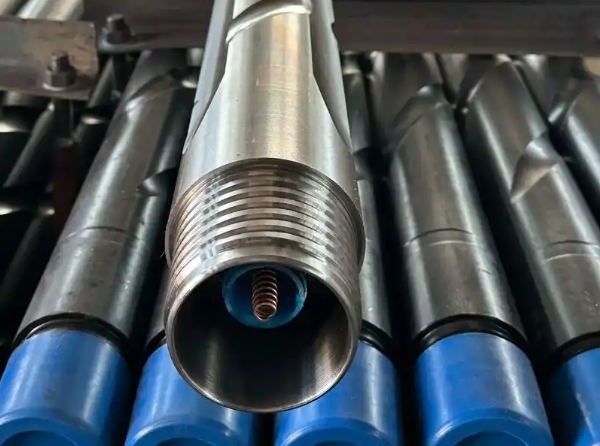Drill rigs are common mechanical tools in daily life, and in the drilling industry, drill pipes are indispensable. This means that users who frequently operate drill rigs need to be familiar with related knowledge. As we know, the role of drill pipes during drilling operations is crucial. So, what are the functions and characteristics of drill pipes?
1. Functions of Drill Pipes:
Drill pipes are used to connect the surface equipment of the drill rig with the drilling and grinding equipment or bottom-hole tools at the bottom of the well. They are steel pipes with threaded ends. The purpose of drill pipes is to transport drilling mud to the drill bit and to raise, lower, or rotate the bottom-hole equipment. Drill pipes must withstand significant internal and external pressures, torsional forces, bending forces, and vibrations. Drill pipes are reusable during the extraction and refining processes.
Raw steel pipes and smooth pipes are transformed into drill pipes through multiple processing steps. First, the pipe undergoes a thickening process, where the outer surface of the smooth pipe is bent inward, and the pipe walls become thicker. The next step involves threading the pipe and coating it with copper to increase its strength. After that, non-destructive quality control is performed, followed by welding the pipe body connections. Then, the pipe body undergoes heat treatment and final processing to eliminate residual stresses from welding. Before the finished drill pipes are painted and packaged, other tests such as hardness tests, pressure tests, and non-destructive tests are conducted. The length of geological drill pipes is typically around 1 meter.
2.Characteristics of Drill Pipe
High strength and pressure resistance: Drill pipes possess high yield strength and compression resistance, allowing them to withstand the enormous pressures and torques generated during drilling.
Corrosion resistance: As the drilling environment is often exposed to corrosive substances such as water, chemicals, and gases, drill pipes are made with corrosion-resistant materials to ensure long-lasting use.
Good ductility and toughness: Drill pipes have excellent ductility and toughness, enabling them to endure stretching and bending stresses without breaking.
Wear resistance: Drill pipes are in constant contact with the formation and the drill bit, requiring strong wear resistance to ensure a longer lifespan.
Customizable length and size: Drill pipes can be made in various lengths and diameters to suit different drilling depths. Standard sizes include R1, R2, and R3.
Strong connectivity: Drill pipes are connected with special joints, typically through threading or welding, ensuring a strong and secure connection.
Adaptability to different drilling operations: Drill pipes are manufactured in different types according to the working environment, such as conventional drilling, deep well drilling, and ultra-deep well drilling, to meet various strength and durability requirements.
High-temperature resistance: Some drill pipes are designed to withstand high temperatures, making them suitable for drilling in extreme temperature environments.

3.Key Features of Drill Pipe:
Material: Drill pipes are typically made from high-strength steel to withstand the extreme conditions encountered during drilling, including high pressure and temperature.
Design: They are designed to be durable and resistant to wear and corrosion, ensuring longevity and reliability during drilling operations.
Connection: Drill pipes are connected using threaded joints, allowing for easy assembly and disassembly as drilling progresses or when changing drill bits.






 English
English Español
Español بالعربية
بالعربية











 Phone :
Phone :  Whatsapp :
Whatsapp :  Email :
Email : 


